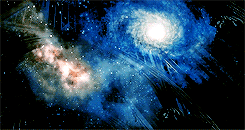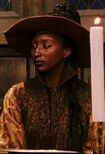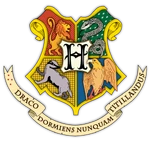
|
Warning!
At least some content in this article is derived from information featured in: Harry Potter: Hogwarts Mystery & Hogwarts Legacy. |

|
"Is this all real? Or has this been happening inside my head?"
The topic of this article is of a real-life subject that has been mentioned "in-universe" in a canon source. The Harry Potter Wiki is written from the perspective that all information presented in canon is true (e.g., Hogwarts really existed), and, as such, details contained in this article may differ from real world facts. |

|
"Sectumsempra!"
It has been suggested that this article be split into multiple articles. (Discuss) |
- "They had to study the night skies through their telescopes every Wednesday at midnight and learn the names of difficult stars and the movement of planets. "
- — Harry Potter's summary of the subject[src]
Astronomy was a subject and core class and taught at Hogwarts School of Witchcraft and Wizardry[3][5] and Uagadou.[6] Astronomy was the branch of magic and science that studied stars and the movement of planets.[3] Students would also use their wands with an Orrery to predict the next eclipse,[4] the only known practical form of magic used in the class.
Uagadou students were known to be skilled in astronomy,[6] implying the teaching that was provided at Uagadou was excellent.
Class information[]
- "It is increasingly rare to find a student who seeks after things celestial (of their own accord), but if you truly desire to chart the courses of the cosmos, you must rid your mind of the terrestrial babble of others. We ourselves are like blank star-charts, you know? Empty canvases waiting to be inscribed with all that the universe has to offer."
- — Professor Satyavati Shah[src]

The study of the stars
Astronomy lessons were spent observing the night skies with telescopes, as well as gaining an understanding of the various phenomena that go on in space, such as Lunar phases and Space weather. Known assignments included learning the names of stars, constellations and planets, as well as charting their locations, movements, and environments.[3] It was a required class from year one until year five,[3] and became an optional subject for the final two years.
Astronomy was not to be confused with the divination practice of astrology. One was concerned with mysteries stellar and lunar, the other was referred to as "mere lunacy".[1]
It is currently unclear exactly how this subject was relevant to the education of witches and wizards, but according to Professor Shah, there was much that could be gleaned from the stars. She believed that people were like blank star charts, empty canvases waiting to be inscribed by all that the universe had to offer. Professor Shah found it increasingly rare to find a student who sought after things celestial (of their own accord). Although, some students, like Amit Thakkar, were fascinated by the concept of infinity and limitless potential, as there was always something new being discovered in space.[1]
The great devoted stargazer's of the past erected stone slabs known as Astronomy Tables throughout the Highlands, from which they gazed toward the heavens millennia ago. They were ideal for studying constellations near and far, and they could be used to find hidden constellations. For centuries, wizardkind made use of them, but they have since become mere monuments to the intrepid intellectual pursuits of a bygone epoch. Some say the locations of the tables were originally marked by Centaurs for ritual Star gazing.[1]
In the fifth year, the Ordinary Wizarding Level examinations were taken. During the exam, students had to fill in a blank star chart.[7]
Wiseacre's Wizarding Equipment in Diagon Alley sold telescopes and other equipment needed for Astronomy.[8] Aurora Sinistra was the Astronomy professor at Hogwarts during Harry Potter's time as a student.[2] She was also teaching during Jacob's sibling's time at Hogwarts.[4]
Location and time[]
Classrooms[]

The Astronomy Tower, where this class was held
Astronomy classes took place in the highest level of the Astronomy Tower, the tallest tower in Hogwarts Castle and included sky observation sessions with telescopes[3] (each student had to buy one of their own).[9]
Lesson times[]
| Year | Day | Period |
|---|---|---|
| First | Wednesday[3] | midnight[3] |
| Fifth | evening |
Curriculum[]
- "Astronomy is not Divination; you won't find the mysteries of the cosmos charted out on you palms or at the bottom of your tea cups. Alas, the heavens remain hazy to the starry-eyed. Now, if you were to devote yourselves to persistent and painstaking observation, you just might catch a glimpse."
- — Professor Satyavati Shah scolding her students[src]
First year[]
During the first year of studies at Hogwarts, students studied the night skies through their telescopes every Wednesday at midnight and learn the different names of the stars and the movements of the planets.[3] Towards the end of the 1991–1992 school year, Hermione Granger was quizzing Ron on Astronomy for preparation for their first year exams. Their studying included using a map of Jupiter.[10] It was noted that the studies on Jupiter continued into later years, when Harry tried to learn the names of Jupiter's moons in his fifth year of study at Hogwarts.[7]
Third year[]
In the 1993–1994 school year, one of the homework assignments included drawing a star chart which probably meant they studied stars that year,[11] and they took a midnight exam at the end of the year.[12]
Fifth year[]
- "Harry, yours is okay except for this bit at the end, I think you must have misheard Professor Sinistra. Europa's covered in ice, not mice."
- — Hermione Granger during the 1995–1996 school year[src]
1890–1891 school year[]
- Constellations[1]
1995–1996 school year[]
Hogwarts students studied Jupiter's moons and wrote an essay for their homework containing facts such as Europa being covered by ice and Io having many volcanoes.[13] They filled in blank star charts[14] and the homework during this year became intensive enough that some students had to organise a meeting to help each other get through it.[15]
For the Astronomy O.W.L. exam in their fifth year, the written exam contained a section on Jupiter. In 1996, it was held on Wednesday morning. The practical exam took place in the evening at eleven o'clock, and each student had to "fill in a blank star chart" based on a few hours of observing the night sky.[7]
When Harry Potter was taking the Astronomy O.W.L. in 1996, Rubeus Hagrid was confronted by Dolores Umbridge and a team of corrupt Aurors in what was an attempted sacking, which was also the night that Minerva McGonagall took "no less than four Stunners to the chest."[7]
Sixth year[]
Sixth-year students studied multiple topics, including:
- Constellations, including Cetus[16]
- Lunar phases[4]
- Star charts[17]
- Cosmic ages[18]
- Space weather[19]
- Meteor showers[20]
Seventh year[]
Seventh-year students studied multiple topics, including:
- Dark cloud constellations[21]
- Rogue planets[22]
- Dark energy and dark matter[23]
- Black holes and wormholes[24]
- Jupiter's moons[25]
Known professors[]
Grades[]
Passing grades[]
|
Fail grades[] |
Known O.W.L.s[]
Behind the scenes[]
- During the O.W.L. exam, Harry focuses his telescope upon Venus at midnight.[7] However, Venus's orbit is closer to the sun, and when it is midnight at a location, that part of the Earth is approximately facing completely away from the sun. Given these two facts, it is highly unlikely that Harry would have been able to see Venus regardless of Britain's high latitude and the proximity to the summer solstice due to line of sight issues, but the telescope may have been magical.
- In the films, the Astronomy class is never seen or directly mentioned, and Professor Sinistra only appears as an unidentified background extra. However, the Astronomy Tower was shown.
- From the fact that it is common knowledge among wizards that Europa is icy and Io has volcanoes, it seems that, despite the separation of wizarding and Muggle cultures (and the wizarding ignorance of other scientific concepts such as electricity), Muggle science is well-known to wizard astronomers. Just how far wizarding knowledge of modern astronomy goes, though, is unknown. However, it is quite possible that the wizarding world has other means of conducting these studies without the use of Muggle technology since Professor Trelawney possessed a globe of the solar system that accurately depicts all the planets (including Pluto) and their moons. Furthermore, Harry Potter found a moving globe of the galaxy in Diagon Alley when he was staying at the Leaky Cauldron during the summer before his third year. This far surpasses the current state of Muggle knowledge, let alone what it was in the early 1990s.
Appearances[]
- Harry Potter and the Philosopher's Stone (First appearance)
- Harry Potter and the Chamber of Secrets (Mentioned only)
- Harry Potter and the Prisoner of Azkaban
- Harry Potter and the Prisoner of Azkaban (film) (Mentioned only)
- Harry Potter and the Goblet of Fire (Mentioned only)
- Harry Potter and the Order of the Phoenix
- Harry Potter and the Order of the Phoenix (video game) (Mentioned only)
- Harry Potter and the Half-Blood Prince (Mentioned only)
- Harry Potter and the Half-Blood Prince (film) (Mentioned only)
- Fantastic Beasts and Where to Find Them (Mentioned only)
- Pottermore (Mentioned only)
- Wizarding World (Mentioned only)
- LEGO Harry Potter: Building the Magical World (Mentioned only)
- LEGO Harry Potter (Mentioned only)
- LEGO Harry Potter (Mentioned only)
- Harry Potter: The Creature Vault (Mentioned only)
- Harry Potter: Hogwarts Mystery
- Hogwarts Legacy
Notes and references[]
- ↑ 1.0 1.1 1.2 1.3 1.4 1.5 Hogwarts Legacy, Main Quest "Astronomy Class"
- ↑ 2.0 2.1 2.2 2.3 Harry Potter and the Chamber of Secrets, Chapter 11 (The Duelling Club)
- ↑ 3.00 3.01 3.02 3.03 3.04 3.05 3.06 3.07 3.08 3.09 3.10 Harry Potter and the Philosopher's Stone, Chapter 8 (The Potions Master)
- ↑ 4.0 4.1 4.2 4.3 4.4 4.5 4.6 Harry Potter: Hogwarts Mystery, Year 6, Chapter 25 (Written in the Stars) - Astronomy Lesson "Lunar Phases"
- ↑ Writing by J. K. Rowling: "Hogwarts School Subjects" at Wizarding World
- ↑ 6.0 6.1 Writing by J. K. Rowling: "Uagadou" at Wizarding World
- ↑ 7.0 7.1 7.2 7.3 7.4 Harry Potter and the Order of the Phoenix, Chapter 31 (O.W.L.s)
- ↑ The Wizarding World of Harry Potter
- ↑ Harry Potter and the Philosopher's Stone, Chapter 5 (Diagon Alley)
- ↑ Harry Potter and the Philosopher's Stone, Chapter 15 (The Forbidden Forest)
- ↑ Harry Potter and the Prisoner of Azkaban, Chapter 8 (Flight of the Fat Lady)
- ↑ Harry Potter and the Prisoner of Azkaban, Chapter 16 (Professor Trelawney's Prediction)
- ↑ Harry Potter and the Order of the Phoenix, Chapter 14 (Percy and Padfoot)
- ↑ Harry Potter and the Order of the Phoenix, Chapter 26 (Seen and Unforeseen)
- ↑ Harry Potter and the Order of the Phoenix (video game) - GBA version
- ↑ Harry Potter: Hogwarts Mystery, Year 6, Chapter 25 (Written in the Stars)
- ↑ Harry Potter: Hogwarts Mystery, Year 6, Chapter 29 (The Whomping Willow Awaits) - Astronomy Lesson "Making Star Charts"
- ↑ Harry Potter: Hogwarts Mystery, Year 6, Chapter 33 (Imitation Game) - Astronomy Lesson "Cosmic Ages"
- ↑ Harry Potter: Hogwarts Mystery, Year 6, Chapter 38 (Meeting the Merqueen) - Astronomy Lesson "Space Weather"
- ↑ Harry Potter: Hogwarts Mystery, Year 6, Chapter 42 (The Final Vault) - Astronomy Lesson (Meteor Showers)
- ↑ Harry Potter: Hogwarts Mystery, Year 7, Chapter 1 (Year Seven Begins) - Astronomy Lesson "Dark Cloud Constellations"
- ↑ Harry Potter: Hogwarts Mystery, Year 7, Chapter 16 (Trials and Tribulations) - Astronomy Lesson "Rogue Planets"
- ↑ Harry Potter: Hogwarts Mystery, Year 7, Chapter 28 (The Last Laugh) - Astronomy Lesson "Dark Matter and Dark Energy"
- ↑ Harry Potter: Hogwarts Mystery, Year 7, Chapter 38 (Tensions Rise) - Astronomy Lesson "Black Holes and Wormholes"
- ↑ Harry Potter: Hogwarts Mystery, Year 7, Chapter 46 (Total Recall) - Astronomy Lesson "Jupiter's Moons"
- ↑ 26.0 26.1 Harry Potter and the Chamber of Secrets, Chapter 4 (At Flourish and Blotts) - It is said that both Percy and Bill Weasley earned twelve Ordinary Wizarding Levels, meaning they must have earned an O.W.L. in this subject.
- ↑ 27.0 27.1 27.2 Harry Potter and the Half-Blood Prince, Chapter 5 (An Excess of Phlegm)
| Astronomy | |||||
|---|---|---|---|---|---|
| Professors: Satyavati Shah · Aurora Sinistra | |||||
| Astronomy at Hogwarts: Astronomy classroom · Astronomy Corridor · Astronomy Club · Astronomy department · Astronomy homework meeting · Astronomy reading room · Astronomy Room · Astronomy Stairs · Astronomy Tower | |||||
| Astronomers: Aurora Sinistra · Copernicus · George von Rheticus · Perpetua Fancourt · Hesper Starkey | |||||
| Objects: Astrolabe · Globe of the Moon · Lunascope · Moon chart · Orrery · Sextant · Star chart · Telescope | |||||
| Planets: Jupiter · Mars · Mercury · Neptune · Pluto · Rogue planets · Saturn · Uranus · Venus | |||||
| Satellites: Callisto · Europa · Ganymede · Io · Moon | |||||
| Constellations: Aquila · Bartholomeus · Cetus · Crater · Dark cloud constellations · Orion · Ursa Major | |||||
| Other topics: Black holes · Cosmic ages · Dark energy · Dark matter · Eclipse · Lunar phases · Meteor showers · Space weather · Wormholes | |||||
| Hogwarts subjects | ||
|---|---|---|
| Core classes | Astronomy · Charms · Defence Against the Dark Arts · Herbology · History of Magic · Potions · Transfiguration | |
| Elective classes | Alchemy · Arithmancy · Care of Magical Creatures · Divination · Muggle Studies · Study of Ancient Runes | |
| Extracurricular classes | Apparition · Advanced Arithmancy Studies · Ancient Studies · Art · Flying · Ghoul Studies · Magical Theory · Muggle Art · Muggle Music · Music · Xylomancy · Field Studies | |
| Former classes | Beasts · Dark Arts | |
| Examinations | ||
| First year exams · Second year exams · Third year exams · Fourth year exams · Ordinary Wizarding Level · Nastily Exhausting Wizarding Test | ||

![Satyavati Shah HL.png (7.02 MB) Satyavati Shah (late 1800s)[1]](https://static.wikia.nocookie.net/harrypotter/images/a/a7/Satyavati_Shah_HL.png/revision/latest/scale-to-width-down/185?cb=20230220185201)
![Professor Aurora Sinistra.jpg (158 KB) Aurora Sinistra (pre. 1985-?)[2][4]](https://static.wikia.nocookie.net/harrypotter/images/8/8a/Professor_Aurora_Sinistra.jpg/revision/latest/scale-to-width-down/126?cb=20210623182519)

![BillWeasleyDH2.png (6.69 MB) Bill Weasley[26]](https://static.wikia.nocookie.net/harrypotter/images/6/66/BillWeasleyDH2.png/revision/latest/scale-to-width-down/105?cb=20160212193938)
![Percy.jpg (33 KB) Percy Weasley[26]](https://static.wikia.nocookie.net/harrypotter/images/6/6a/Percy_Weasley_COSF.jpg/revision/latest/scale-to-width-down/185?cb=20150828155322)
![Hermione Granger Half Blood Prince.jpg (65 KB) Hermione Granger[27]](https://static.wikia.nocookie.net/harrypotter/images/9/94/Hermione_Granger_Half_Blood_Prince.jpg/revision/latest/scale-to-width-down/105?cb=20211007194857)
![HBP promo side Harry cropped.jpg (60 KB) Harry Potter (May not have qualified for N.E.W.T.)[27]](https://static.wikia.nocookie.net/harrypotter/images/9/9f/HBP_promo_side_Harry_cropped.jpg/revision/latest/scale-to-width-down/105?cb=20190125054228)
![Ron Weasley Half Blood Prince.jpg (9 KB) Ron Weasley (May not have qualified for N.E.W.T.)[27]](https://static.wikia.nocookie.net/harrypotter/images/0/01/Ron_Weasley_Half_Blood_Prince.jpg/revision/latest/scale-to-width-down/105?cb=20141122220248)
![Jacob's sibling generic.png (175 KB) Jacob's sibling[4]](https://static.wikia.nocookie.net/harrypotter/images/b/b4/Jacob%27s_sibling_generic.png/revision/latest/scale-to-width-down/112?cb=20200428175803)
![Penny Haywood HM8.png (273 KB) Penny Haywood[4]](https://static.wikia.nocookie.net/harrypotter/images/4/4a/Penny_Haywood_HM8.png/revision/latest/scale-to-width-down/140?cb=20230824092112)

